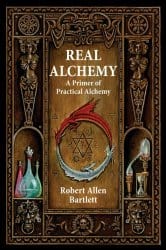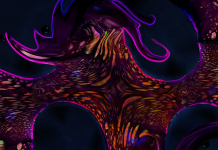
 Real Alchemy: A Primer of Practical Alchemy, by Robert Allen Bartlett
Real Alchemy: A Primer of Practical Alchemy, by Robert Allen Bartlett
Ibis Press, 9780892541508, 178 pp. (incl. appendices and bibliography), 2009
…alchemy is not a smooth monolithic system, but rather a journey full of contradictions, false turns and dazzling insights into the worlds of creation. At times it seems to defy a single definition. But, in its most general, all-encompassing form, we can say with some degree of confidence that alchemy is the art and science of bringing something to its final perfection.
— Brian Cotnoir, from the first Preface
To most people, alchemy might conjour images of ancient bearded men in dimly lit rooms hovering over various malodourous substances connected by an arcane network of tubes, beakers bubbling away, struggling in earnest to produce gold from lead. Those more familiar with Carl Jung‘s work might imagine that all this fancy is well and good, but, of course, it’s all allegorical, beneath which is philosophy deeply concerned with transforming the alchemist hirself. Bartlett argues that, for modern alchemists, there’s truth to both images.
Alchemy is more than just something you do in a laboratory. It is a spiritual path leading one to enlightenment — to evolving. It can be thought of as a psycho-physiological transformation directed by human self-consciousness.1
Bartlett began his formal study of alchemy in 1974 at the Paracelsus Research Society (later renamed Paracelsus College), studying under Dr Albert Reidel, or Frater Albertus, and later finished a degree in chemistry. As one might expect with this grounding in physical chemistry, Real Alchemy deals largely with physical alchemical work.
Though before we come to that, Bartlett offers a brief history and etymology of alchemy, as well as introducing basic alchemical theory, the four elements (earth, air, fire and water), the three essentials (salt, sulphur, mercury), duality, Hermes Trismegistus, and touches on the importance of astrology.
Bartlett provides comprehensive instruction on spgyrics, or practical laboratory alchemy. There are many practical examples detailing how to create various alchemical substances, salt, tartars, ens, and oils of various substances. Experiments begin with plant-based alchemy, which leads into metals-based alchemy with appropriate warnings.2
Real Alchemy is a ready reference manual for starting one’s own alchemical laboratory. Yet it seems lacking examples of practical application from the author’s experience. The reader learns that various substances may – despite the large all-caps warning at the beginning of the book – add various substances to wine or water for fantastic effects, but as to what these effects might be, only the truly intrepid may discover, as no clear description is ever given. (What happens when one ingests oil of lead, for example?) Nor is any explanation given as to why one go to the trouble of creating one potion over another.
Alchemy seems to be long, patient work with some workings taking months – even years – to mature. While Bartlett asserts that one can usually start with tools already found in the kitchen, I could be a little clearer with why one might start in the first place.
Peppered throughout the text are quotations taken from alchemical texts, though awkwardly and inconsistently formatted, they offer insight into the alchemical mind. Illustrations helpfully depict alchemical equipment and esoteric symbolism.
Laboratory alchemy seems charming in an archaic, romantically anachronistic way: a living study of medieval and Renaissance practices. Perhaps it’s meaningful in that sense, but I remain unconvinced of its efficacy. However, if this sounds like your cup of chai, Real Alchemy certainly offers plenty of practical material to get you started.
- p. 40, I assume by “self-consciousness” Bartlett is actually aiming for something akin to self-awareness, not awkward gawky teenage angst. [↩]
- p. 99 [↩]








